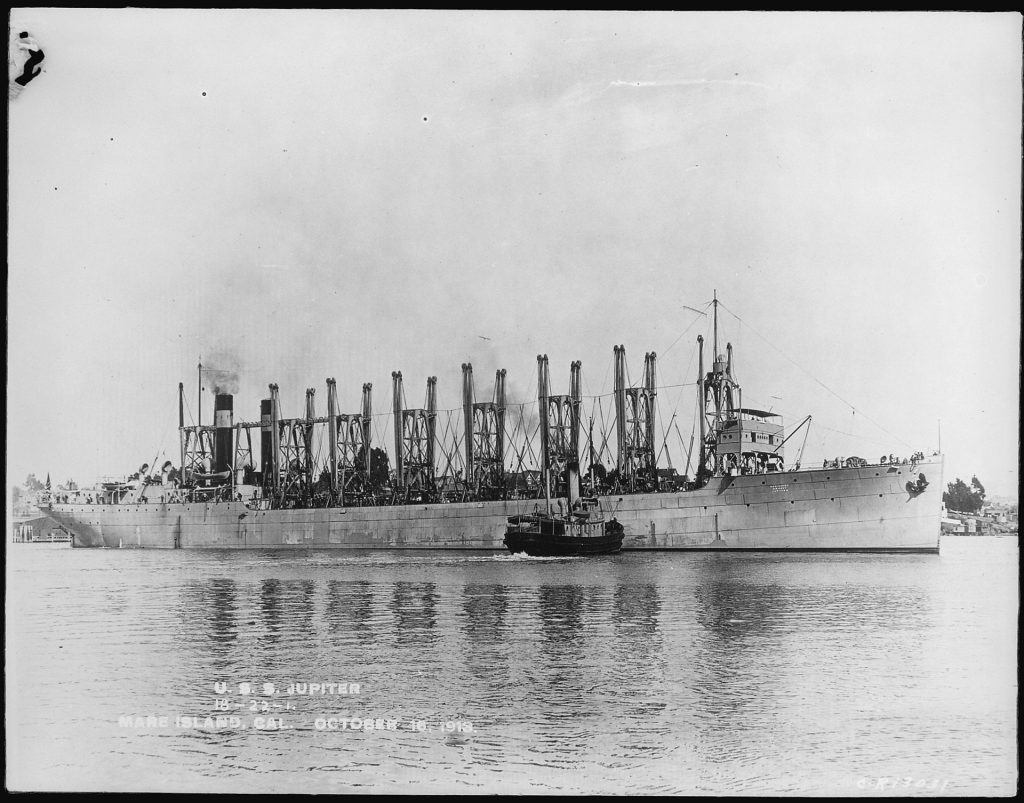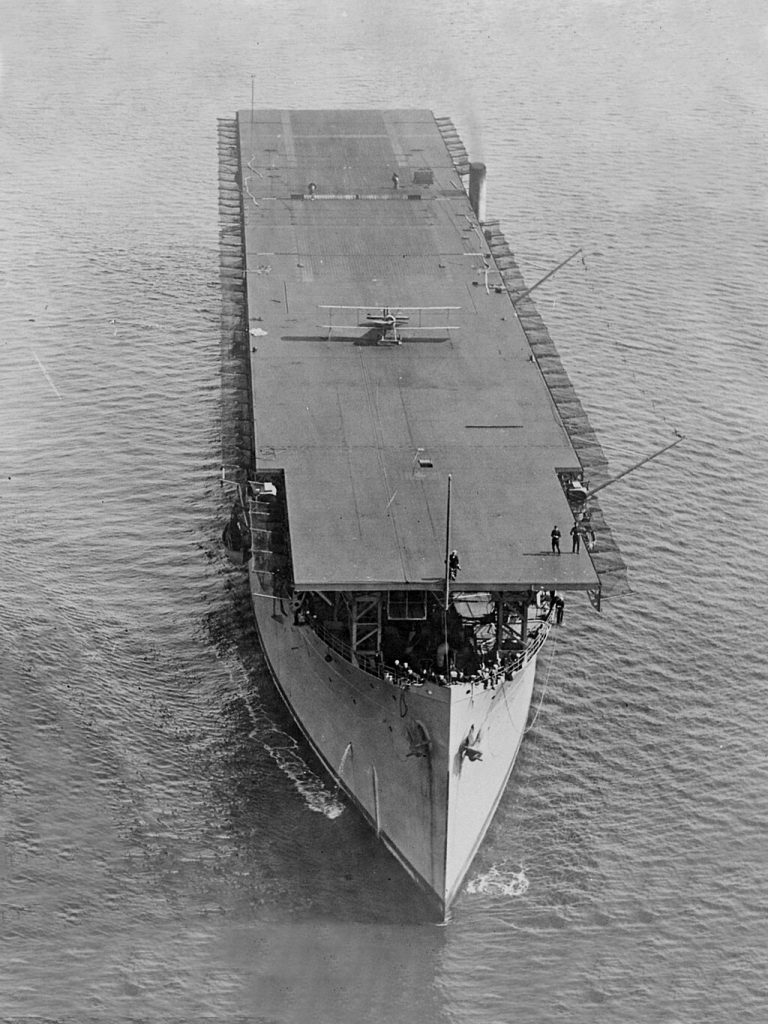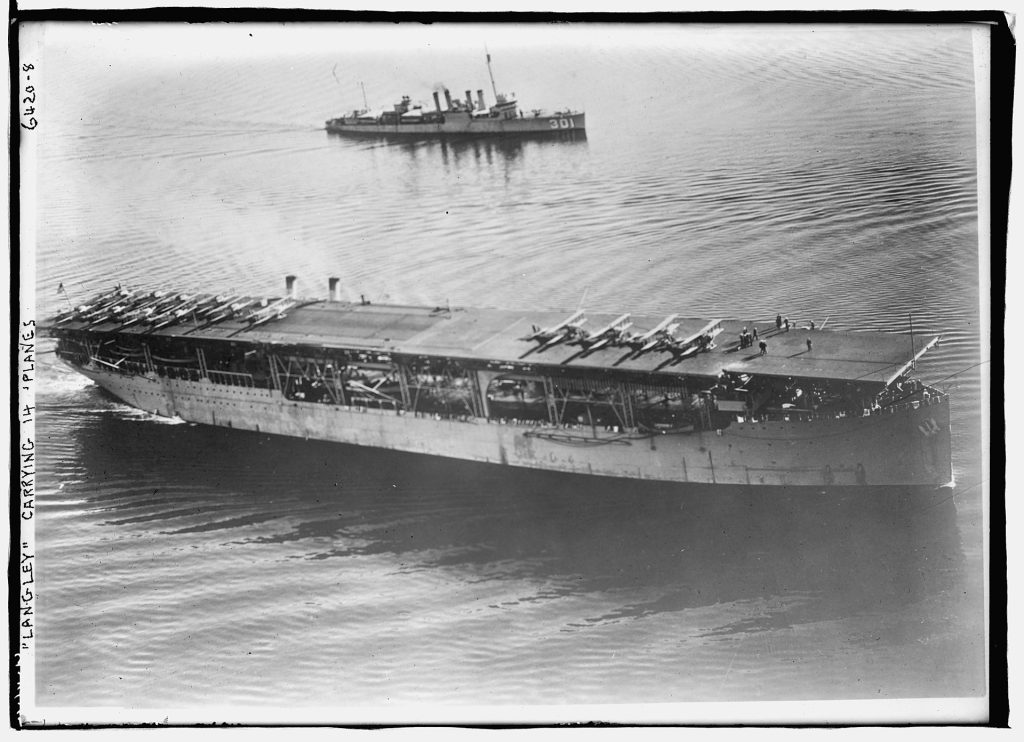The USS Langley, originally commissioned as the collier USS Jupiter, was the United States Navy’s first aircraft carrier, playing a pivotal role in the development of naval aviation during the early 20th century.

Serving as a crucial experimental platform, the Langley laid the foundational tactics, techniques, and training methods that would shape the future of naval air operations.
Despite its transformation into a seaplane tender in later years, its ultimate sinking during World War II marked the end of an era, but its legacy in naval warfare continues to be felt today.
Historical Context
The global landscape following World War I was replete with changes, both in geopolitical dynamics and technological advancements.
The Great War had introduced the world to the horrors and possibilities of modern warfare, particularly with the integration of air power into traditional military strategies.
The use of airplanes in WWI was transformative; what started as a tool for observation balloons and rudimentary reconnaissance missions had evolved into bombing raids and dogfights in the skies.
This integration of aerial capabilities was a direct reflection of the innovations of the Industrial Age.
Factories that once churned out consumer goods were now mobilized for war, producing advanced machinery like tanks, machine guns, and, of course, airplanes.
The rapid development and deployment of aircraft during the war signaled a shift in military thinking. No longer were battles constrained to land and sea; the sky had become the new frontier.
For naval powers, particularly those with extensive overseas territories and interests like the United States, this presented both a challenge and an opportunity.
The challenge was evident: naval fleets, once the uncontested rulers of the oceans, were now vulnerable to attacks from the air.
Ships that were designed to repel attacks from the surface and below now had to contend with threats from above.
The sinking of battleships and cruisers by aircraft during the war had made the vulnerabilities of traditional naval vessels to aerial assaults painfully clear.
However, the opportunity was equally compelling. If navies could harness the power of aviation, they could project power in ways previously unimagined.
Aircraft could extend the range of a naval fleet, offering reconnaissance far beyond the horizon and delivering precision strikes against enemy assets before naval guns were even in range.
The marriage of sea power with air power promised a revolution in naval strategy, and major naval forces around the world took note.
Amidst this backdrop of change and potential, the idea of a ship designed specifically to carry, launch, and recover aircraft was born.
The USS Langley, converted from the collier USS Jupiter, would become the United States’ first experiment in realizing this concept, marking the dawn of a new era in naval warfare where the dominance of the seas would be intrinsically linked to the mastery of the skies.
Genesis Of The USS Langley
The USS Jupiter (AC-3) was originally commissioned in 1913 as a collier. Colliers were ships designed primarily for transporting coal for the Navy.
In an era where many naval vessels were still coal-powered, the Jupiter’s role was essential.
It served the fleet by ensuring that ships had the fuel they needed to operate, especially during extended voyages.
 The collier USS Jupiter before becoming USS Langley.
The collier USS Jupiter before becoming USS Langley.
However, its life as a coal carrier was destined to be short-lived. As the world was shifting its strategic focus in the post-World War I landscape, so too were the roles and purposes of naval vessels.
By 1920, naval strategists and visionaries began to perceive the latent potential in the USS Jupiter.
The ship’s large, flat deck and spacious hull, originally designed to accommodate vast amounts of coal, presented an intriguing possibility.
With some modification, could the Jupiter be transformed into a seafaring platform from which aircraft could be launched and recovered?
This question led to a dramatic repurposing of the Jupiter. Named in honor of Samuel Pierpont Langley, an American aviation pioneer who made significant contributions to the development of heavier-than-air flight, the USS Jupiter was rechristened as the USS Langley (CV-1) in 1920.
This wasn’t just a simple renaming; the vessel underwent extensive modifications to serve its new role.
 USS Jupiter receiving modifications to become USS Langley.
USS Jupiter receiving modifications to become USS Langley.
The most visually striking change was the construction of a wooden flight deck over the ship’s existing structure.
The Langley’s design was unique, eschewing the traditional “island” superstructure commonly found on later aircraft carriers.
This expansive, uninterrupted deck provided a relatively clear and level surface, making it conducive for early experiments in naval aviation.
Underneath this flight deck, the vast spaces previously used to store coal were reconfigured.
New compartments were designed to store aircraft, aviation fuel, munitions, and the myriad tools and parts necessary to maintain a fleet of aircraft at sea.
The Langley was also fitted with arresting gear — a series of cables and hooks designed to catch landing aircraft and bring them to a stop.
While the USS Langley was not the world’s first ship modified to support aircraft operations (that honor goes to the British HMS Furious), its transformation marked a significant commitment by the United States to explore the future of naval aviation.
This ‘experiment’ was the nation’s first dedicated step into merging the realms of sea and sky, setting a precedent for generations of American aircraft carriers to come.
The Pioneering Role
At its core, the USS Langley was a floating laboratory. Given that naval aviation was in its infancy during the Langley’s operational years, there was a plethora of uncharted territory to navigate.
How does one safely launch and recover an aircraft from a moving ship?
What designs and mechanisms were required to ensure swift and safe takeoffs and landings on a restricted deck space?
These were questions with no established answers, and it was upon the deck of the Langley that these solutions were painstakingly derived.
Pioneering aviators, risking life and limb, embarked on a series of trial-and-error experiments aboard the Langley.
They tested different catapult systems for takeoff and practiced landing techniques using arresting gear, which consisted of wires and tailhooks designed to catch and halt an incoming aircraft. These endeavors were fraught with challenges.
Many early attempts resulted in crashes or near misses, but with each failure came invaluable data.
Lessons were learned, designs were refined, and slowly but surely, the complex dance of aircraft operations on a ship began to take shape.
 A view of the USS Langley a year after she was commissioned.
A view of the USS Langley a year after she was commissioned.
Beyond the physical mechanisms of flight operations, the Langley was instrumental in crafting the tactics and procedures that would become standard in naval aviation.
Aircraft deployment strategies, communication codes between pilots and deck crew, and emergency protocols were all formulated and fine-tuned aboard the Langley.
The ship’s unique role as an experimental vessel meant that it was constantly evolving, adapting, and improving its practices.
However, the Langley’s contributions weren’t restricted to mere techniques and tactics. It became the crucible for training a new generation of naval aviators. The lessons, both successful and failed, provided invaluable hands-on experience for pilots.
These aviators would become the first of a lineage, imparting their knowledge and experience to subsequent generations.
Some of the pilots trained on the Langley would go on to play significant roles in World War II, bringing with them the foundational knowledge garnered from their time on this pioneering vessel.
The USS Langley In Action
Upon its conversion to an aircraft carrier, the USS Langley was quickly thrust into fleet exercises alongside other naval vessels.
These exercises were crucial for several reasons. Firstly, they offered a real-world setting to test the tactics and strategies developed on the Langley’s deck.
How would aircraft launched from a carrier integrate with battleship operations?
Could the Langley’s aircraft effectively scout for the fleet, extending its visibility far beyond the horizon? These were some of the operational questions that could only be answered in the context of broader naval maneuvers.
As the Langley participated in these exercises, it provided the U.S. Navy with a clearer understanding of the aircraft carrier’s tactical potential.
For instance, the ability of the Langley’s aircraft to act as spotters for naval artillery, directing gunfire with greater accuracy, showcased how aircraft could enhance the offensive capabilities of traditional naval vessels.
Furthermore, the use of aircraft for reconnaissance and early warning against enemy movements underscored the importance of aerial assets in naval defense.
Yet, the integration of the Langley into fleet operations was not without its challenges.
Coordinating movements between the carrier and other vessels, ensuring seamless communication between airborne units and ships, and addressing the vulnerabilities of the carrier itself were all operational challenges that emerged.
 USS Langley with fourteen aircraft on her deck.
USS Langley with fourteen aircraft on her deck.
The Langley, with its slower speed and lack of heavy armaments, required protection from more robust naval vessels, emphasizing the need for comprehensive fleet tactics that accounted for the strengths and weaknesses of each ship type.
In 1937, reflecting the U.S. Navy’s evolving needs and perhaps also the rapid advancements in carrier design, the USS Langley underwent another transformation. It was reclassified as a seaplane tender, designated AV-3.
In this role, instead of launching and recovering traditional carrier aircraft, the Langley now supported seaplane operations.
Seaplanes, with their ability to be launched from water, provided the Navy with another dimension of air operations, especially in areas where carrier operations might be challenging.
The Langley’s operational life as a seaplane tender was, however, relatively short.
Its participation in World War II, and its subsequent fate, would be its final chapter in active service.
What Was Thе World’s First Aircraft Carriеr?
Thе first aircraft carried globally was thе HMS Furious, crеatеd by thе British Navy in World War I.
It was initially a battlеship but transformed into a carriеr in 1917 to launch airplanеs.
This ship played a vital role in thе dеvеlopmеnt of naval aviation by carrying and dеploying aircraft, changing how wars wеrе fought at sеa.
Thе HMS Furious pavеd thе way for futurе aircraft carriеrs, dеmonstrating thе significancе of airbornе powеr in naval warfarе during thе еarly 20th century.
Fate
By the time World War II broke out, the USS Langley, reconfigured as a seaplane tender, was operating in the Pacific.
As the war escalated, and Japan’s aggressive expansion threatened American and Allied interests, the Langley was thrust into a logistical support role, ferrying aircraft and supplies to various bases in the region.
Despite its reclassification, the Langley’s role as a carrier of aircraft—albeit now on its deck rather than launching from it—highlighted its ongoing relevance to the war effort.
However, on February 27, 1942, while en route to deliver Curtiss P-40 Warhawk fighters to Java, the Langley met its tragic end.
Japanese land-based aircraft targeted the vessel, dropping bombs that left the Langley incapacitated.
Recognizing the dire situation and with the ship listing heavily, the order was given to abandon ship.
Later that day, the U.S. destroyers USS Whipple and USS Edsall, which had been escorting the Langley, finished the job by firing shells and torpedoes to sink the stricken vessel, preventing its capture by the enemy.
The loss of the Langley was mourned by the U.S. Navy, not only for its immediate impact on the war effort but also for its symbolic significance.
The Langley, the Navy’s first foray into naval aviation, represented a bridge between old and new naval strategies, and its sinking was a visceral reminder of the dangers faced by naval forces in the Pacific theatre.
Yet, even in its demise, the Langley’s legacy was undeniable. The lessons derived from its operational history—from its days as an experimental aircraft carrier to its final role as a seaplane tender—had already influenced the design, operation, and tactical deployment of a new generation of American aircraft carriers.
Vessels like the USS Enterprise, USS Yorktown, and USS Lexington, which played crucial roles in the Pacific War, owed much of their operational doctrine and design to the pioneering work done aboard the Langley.





